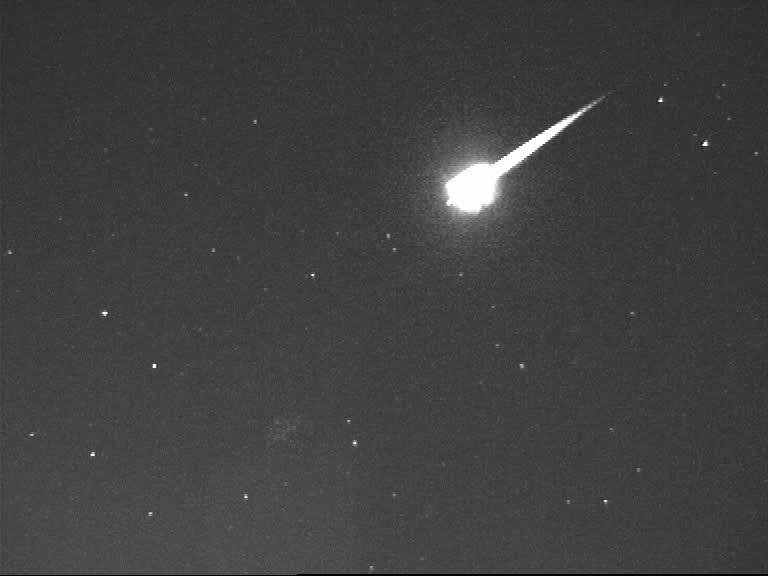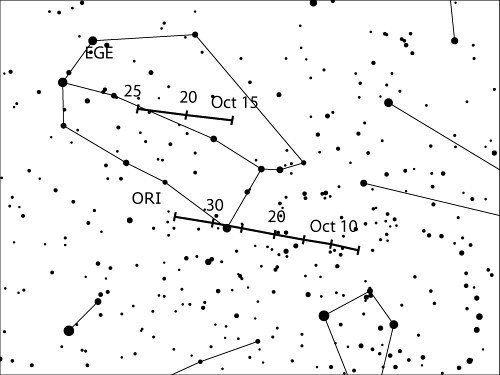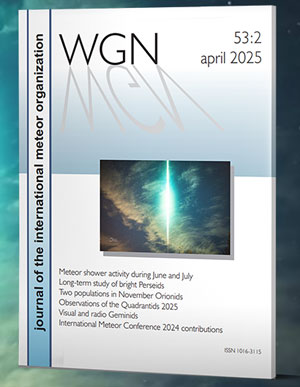October brings the first major meteor shower in nearly three months – the Orionids. Pack your winter gear, set your alarm clocks for early morning hours and enjoy this beautiful meteor shower!
When and how to observe?
The Orionids are going to make you get up early! The radiant rises around 10 PM, so no Orionids will be visible in the evening hours. As the radiant rises in the morning hours, so does the number of Orionids and you can expect the highest number in the hour or two before dawn. This year is a good year for the Orionids, as Moon is out of the sky in the morning hours, providing dark skies for observers.

The Orionids at a glance
The Orionid meteor shower is a moderately strong meteor shower. While nowhere nearly as strong as the Perseids or the Geminids, the Orionids nonetheless provide a beautiful celestial fireworks display. The meteoroids that make up the Orionids are crumbs of the most famous comet of all – 1P/Halley. To make things more interesting, we pass through the stream of Halley crumbs not once, but twice a year. The other time we do is in May and the meteor shower is the Eta Aquariids.
The first Orionids appear on October 2, slowly building up to a rather prolonged maximum on October 21 and then diminishing. The final Orionids appear on November 7. Peak ZHR (Zenithal Hourly Rate) is usually between 15 and 30 meteors per hour, and appears to display a 12-year periodicity. We are currently in the lowest activity phase, so ZHR may be closer to 20. Do not let this discourage you! Orionids are well known for their variabiltiy and outbursts. There were observed outbursts of this meteor shower in 1993, 1998 and 2006-2009, during some of which the Orionids approached the strength of the strongest annual meteor showers! No predictions are in effect for 2015, but as with all meteor showers there are no guarantees.

During the shower’s activity the radiant of the Orionids drifts through much of Orion and well into Gemini. On the peak night the radiant approximately two thirds of the way from Betelgeuse in Orion to gamma Geminorum, the 2nd magnitude star in the SW corner of Gemini. With a velocity of 66 km/s the Orionids are swift meteors which often leave persistent trains. Expect also occasional fireballs which can produce persistent trains that hang in the sky for minutes.
To observe the Orionids, you need to dress warmly, bring a reclining chair and watch the sky. You need no other equipment. Find a dark observing spot, preferably with a low horizon and look in any (the darkest) direction.
Use this light pollution map to find dark locations near you.
But you can also contribute valuable observational data! If you decide to do so, use the IMO major meteor shower observing technique. This way your data will be in a standard format, that can readily be used for analysis. Send us your data as soon after the observations as possible.
How to photograph the Orionids
Meteor photography is a lot of fun! Chances of photographing a bright Orionid are quite good. With modern cameras it is also really easy. You will need a photo tripod, a remote/programmable release and a suitable camera. With modern cameras the selection has expanded from DSLRs also to mirrorless and other types of cameras. The only requirements are: good performance at medium to high ISO (>800-1600), a reasonably fast and wide field lens (f/3.5 or faster is preferable). Put the camera on the tripod and aim it at the sky – it does not matter which part, meteors appear everywhere. Set the exposure to at least 15 sec, but you can go up to several minutes if the sky is dark or if the lens is slow or if you are using comparatively low ISO. Continue making successive photos throughout the night. On the peak night you are bound to catch some good meteors!




 You saw something bright and fast? Like a huge shooting star? Report it: it may be a fireball.
You saw something bright and fast? Like a huge shooting star? Report it: it may be a fireball.  You counted meteors last night? Share your results with us!
You counted meteors last night? Share your results with us!  You took a photo of a meteor or fireball? You have a screenshot of your cam? Share it with us!
You took a photo of a meteor or fireball? You have a screenshot of your cam? Share it with us!  You caught a meteor or fireball on video? Share your video with us!
You caught a meteor or fireball on video? Share your video with us!